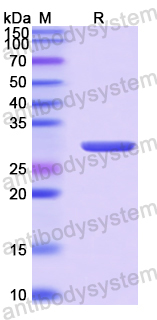Catalog No.
YVV02701
Expression system
E. coli
Species
Tick-borne encephalitis virus (TBEV)
Protein length
Gly2512-Cys2776
Predicted molecular weight
31.96 kDa
Nature
Recombinant
Endotoxin level
Please contact with the lab for this information.
Purity
>90% as determined by SDS-PAGE.
Accession
AHM02467.1
Applications
ELISA, Immunogen, SDS-PAGE, WB, Bioactivity testing in progress
Form
Lyophilized
Storage buffer
Lyophilized from a solution in PBS pH 7.4, 0.02% NLS, 1mM EDTA, 4% Trehalose, 1% Mannitol.
Reconstitution
Reconstitute in sterile water for a stock solution. A copy of datasheet will be provided with the products, please refer to it for details.
Shipping
In general, proteins are provided as lyophilized powder/frozen liquid. They are shipped out with dry ice/blue ice unless customers require otherwise.
Stability and Storage
Use a manual defrost freezer and avoid repeated freeze thaw cycles. Store at 2 to 8°C for one week. Store at -20 to -80°C for twelve months from the date of receipt.
Alternative Names
NS5, MRNA cap 0-1 NS5-type MT
Antigen-specific T cell responses following single and co-administration of tick-borne encephalitis, Japanese encephalitis, and yellow fever virus vaccines: Results from an open-label, non-randomized clinical trial-cohort., PMID:40019865
Remdesivir is active in vitro against tick-borne encephalitis virus and selects for resistance mutations in the viral RNA-dependent RNA polymerase., PMID:39973341
Multi-protomics analysis identified host cellular pathways perturbed by tick-borne encephalitis virus infection., PMID:39616195
[Changes in the Genome of the Tick-Borne Encephalitis Virus during Cultivation]., PMID:39355885
The Flavivirus Non-Structural Protein 5 (NS5): Structure, Functions, and Targeting for Development of Vaccines and Therapeutics., PMID:39203991
Poor virus-specific T-cell responses early after tick-borne encephalitis virus infection correlate with disease severity., PMID:39133062
Langat virus inhibits the gp130/JAK/STAT signaling by reducing the gp130 protein level., PMID:38533889
Tiratricol inhibits yellow fever virus replication through targeting viral RNA-dependent RNA polymerase of NS5., PMID:37879570
Tick-borne flavivirus NS5 antagonizes interferon signaling by inhibiting the catalytic activity of TYK2., PMID:37860832
LGP2 directly interacts with flavivirus NS5 RNA-dependent RNA polymerase and downregulates its pre-elongation activities., PMID:37656756
Crystal structure and cap binding analysis of the methyltransferase of langat virus., PMID:36347437
Tick-borne encephalitis virus capsid protein induces translational shutoff as revealed by its structural-biological analysis., PMID:36223838
Identification of Host Factors Differentially Induced by Clinically Diverse Strains of Tick-Borne Encephalitis Virus., PMID:36098513
Molecular basis of Tick Born encephalitis virus NS5 mediated subversion of apico-basal cell polarity signalling., PMID:35670457
Exploration of binary protein-protein interactions between tick-borne flaviviruses and Ixodes ricinus., PMID:33676573
Crystal structure of a tick-borne flavivirus RNA-dependent RNA polymerase suggests a host adaptation hotspot in RNA viruses., PMID:33406260
An RNA-dependent RNA polymerase inhibitor for tick-borne encephalitis virus., PMID:32452412
An E460D Substitution in the NS5 Protein of Tick-Borne Encephalitis Virus Confers Resistance to the Inhibitor Galidesivir (BCX4430) and Also Attenuates the Virus for Mice., PMID:31142664
Epidemiology, Pathogenesis, and Control of a Tick-Borne Disease- Kyasanur Forest Disease: Current Status and Future Directions., PMID:29868505
Tick-Borne Encephalitis Virus Nonstructural Protein NS5 Induces RANTES Expression Dependent on the RNA-Dependent RNA Polymerase Activity., PMID:29760190
Comparative genome analysis of Alkhumra hemorrhagic fever virus with Kyasanur forest disease and tick-borne encephalitis viruses by the in silico approach., PMID:29745301
Hungarian tick-borne encephalitis viruses isolated from a 0.5-ha focus are closely related to Finnish strains., PMID:29655579
A database of human genes and a gene network involved in response to tick-borne encephalitis virus infection., PMID:29297316
Adaptation of tick-borne encephalitis virus from human brain to different cell cultures induces multiple genomic substitutions., PMID:28631054
Utilisation of ISA Reverse Genetics and Large-Scale Random Codon Re-Encoding to Produce Attenuated Strains of Tick-Borne Encephalitis Virus within Days., PMID:27548676
Prevalence and phylogenetic analysis of tick-borne encephalitis virus (TBEV) in field-collected ticks (Ixodes ricinus) in southern Switzerland., PMID:25245773
Identification of linear human B-cell epitopes of tick-borne encephalitis virus., PMID:24946852
A critical determinant of neurological disease associated with highly pathogenic tick-borne flavivirus in mice., PMID:24574402
Comprehensive assessment of the genetics and virulence of tick-borne encephalitis virus strains isolated from patients with inapparent and clinical forms of the infection in the Russian Far East., PMID:23735441
Phylogeographic characterization of tick-borne encephalitis virus from patients, rodents and ticks in Slovenia., PMID:23185257
Two PDZ binding motifs within NS5 have roles in Tick-borne encephalitis virus replication., PMID:22796133
[Molecular evolution of the tick-borne encephalitis and Powassan viruses]., PMID:22642104
TRIM79α, an interferon-stimulated gene product, restricts tick-borne encephalitis virus replication by degrading the viral RNA polymerase., PMID:21925107
Assessing ubiquitination of viral proteins: Lessons from flavivirus NS5., PMID:21855635
Microclimate and the zoonotic cycle of tick-borne encephalitis virus in Switzerland., PMID:21661323
First complete genomic characterization of two tick-borne encephalitis virus isolates obtained from wild rodents in South Korea., PMID:21286797
Chimeric tick-borne encephalitis/dengue virus is attenuated in Ixodes scapularis ticks and Aedes aegypti mosquitoes., PMID:21142950
Prevalence of tick-borne encephalitis virus in ticks from southern Korea., PMID:20706026
The neurovirulence and neuroinvasiveness of chimeric tick-borne encephalitis/dengue virus can be attenuated by introducing defined mutations into the envelope and NS5 protein genes and the 3' non-coding region of the genome., PMID:20594569
Tick-borne encephalitis virus delays interferon induction and hides its double-stranded RNA in intracellular membrane vesicles., PMID:20554782
Rac1 and Scribble are targets for the arrest of neurite outgrowth by TBE virus NS5., PMID:20363326
Flavivirus NS5 associates with host-cell proteins zonula occludens-1 (ZO-1) and regulating synaptic membrane exocytosis-2 (RIMS2) via an internal PDZ binding mechanism., PMID:19199833
Tick-borne encephalitis virus NS5 associates with membrane protein scribble and impairs interferon-stimulated JAK-STAT signalling., PMID:18042258
A tick-borne Langat virus mutant that is temperature sensitive and host range restricted in neuroblastoma cells and lacks neuroinvasiveness for immunodeficient mice., PMID:16415020
Phosphorylation of tick-borne encephalitis virus NS5 protein., PMID:9178492
Antibodies against tick-borne encephalitis virus (TBEV) non-structural and structural proteins in human sera and spinal fluid., PMID:7590902
Identification of RNA replicase subunits responsible for initiation of RNA synthesis of tick-borne encephalitis virus by affinity labelling., PMID:1772972
[Nucleotide sequence of the genome and complete amino acid sequence of a polyprotein of the tick-borne encephalitis virus]., PMID:2624591

